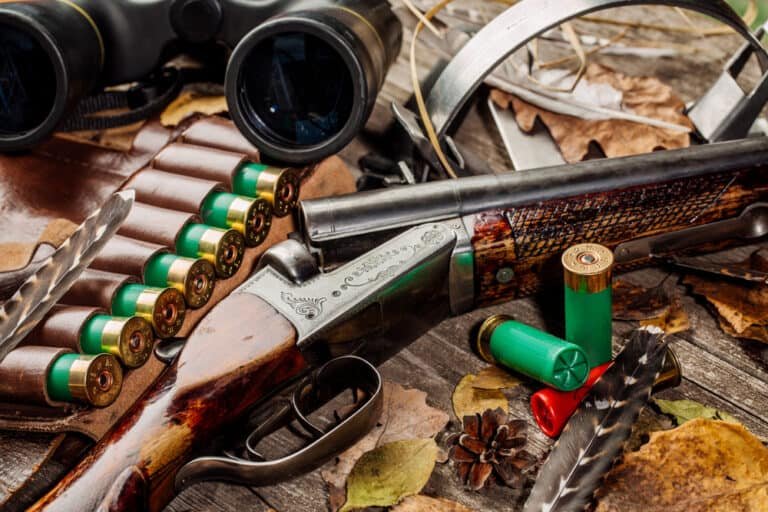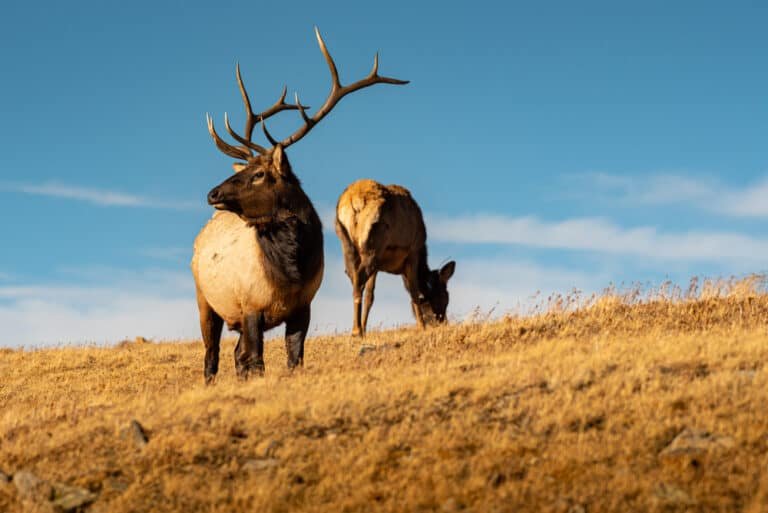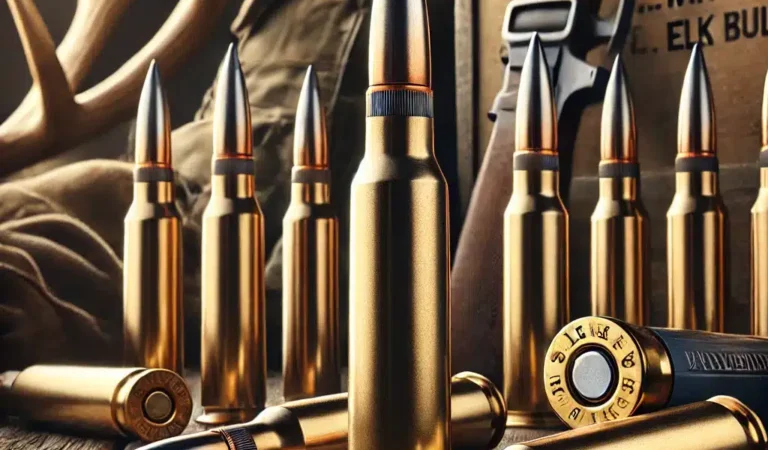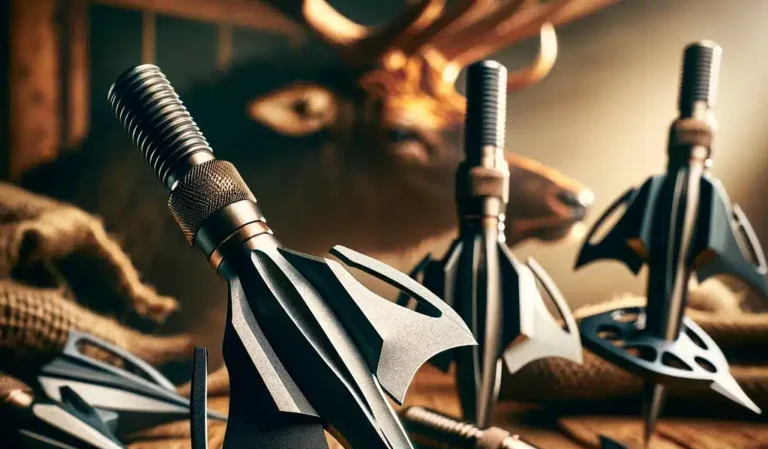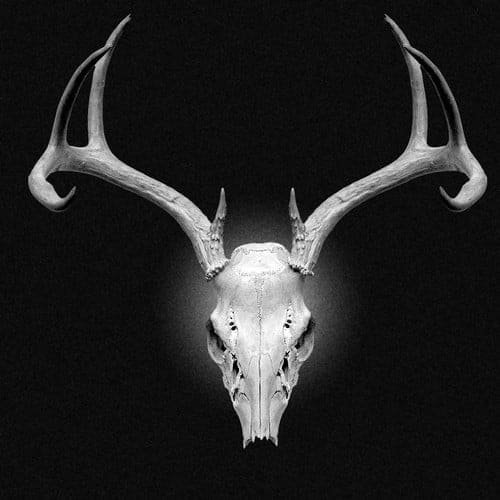Alaska Elk Hunting: The Powerful Guide for Your Hunt in 2024
Tracking Roosevelt elk through the misty rainforests of Afognak Island, where the crash of waves meets the call of bulls echoing through old-growth spruce — this is Alaska elk hunting, unlike anything else in North America.

As far as hunting adventures go, pursuing elk in Alaska sits in a class of its own. While most hunters dream of stalking elk through Colorado’s aspens or Montana’s mountains, few realize that the Last Frontier offers one of the most unique elk hunting experiences in the world.
Here on the emerald islands of Alaska’s southern coast, Roosevelt elk roam through landscapes where dense coastal forests meet the North Pacific.
Unlike their mainland cousins, Alaska’s elk population is concentrated primarily on Afognak and Raspberry Islands, creating an intimate hunting ground where success depends as much on understanding the marine weather as it does on traditional elk hunting skills.
Whether you’re a seasoned hunter looking for your next great adventure or planning your first elk hunt, Alaska’s distinctive combination of coastal wilderness and Roosevelt elk presents both extraordinary challenges and unmatched rewards.
In this guide, we’ll walk through everything you need to know to plan, prepare for, and succeed on your Alaska elk hunt.
From navigating permit systems to essential gear choices that could make or break your hunt in this demanding environment, we’ve got you covered.
Planning Your Alaska Elk Hunt
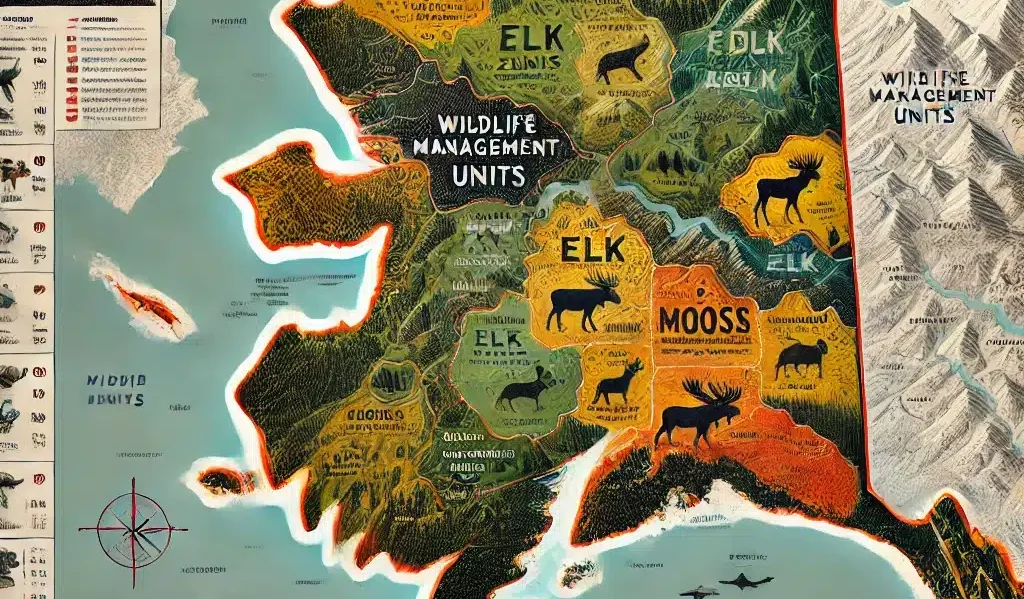
Hunting elk in Alaska isn’t something you can do on a whim. Success starts with careful planning, often a year or more in advance. But don’t let that discourage you – we’ll break down exactly what you need to know.
When to Go
Alaska’s prime elk hunting season runs from October through November, with specific dates varying by unit. While October offers milder weather, November brings the rut – when bulls are most active and vocal. Here’s what you can expect each month:
October
- More predictable weather patterns
- Better visibility conditions
- Elk following regular feeding patterns
- Easier hiking conditions
- Average temperatures: 35-45°F
November
- Peak rutting activity
- More vocal bulls
- Challenging weather possible
- Shorter daylight hours
- Average temperatures: 25-35°F
Licenses and Permits

For Residents
- Alaska hunting license ($45)
- Elk drawing permit (application fee: $5)
- Must apply during November-December for next year’s hunt
For Non-Residents
- Alaska hunting license ($160)
- Elk drawing permit (application fee: $5)
- Must hire a licensed guide or hunt with a close relative who’s an Alaska resident
- Guide services typically range from $12,000-$15,000
The Real Costs
Let’s talk money – because an Alaska elk hunt is a significant investment. Here’s a realistic breakdown:
Transportation
- Flight to Kodiak: $500-800
- Float plane to Afognak: $300-500 per person (round trip)
- Water taxi service: $200-400
Gear and Equipment
- Weather-appropriate gear: $1,000-2,000 (if starting from scratch)
- Weapon and ammunition: $800-1,500
- Camping equipment: $500-1,000
Guide Service (if required)
- 7-10 day hunt: $12,000-15,000
- Includes food, lodging, and field preparation
- Tips for guides: $1,000-1,500 (customary)
Additional Expenses
- Meat processing: $400-600
- Shipping meat home: $300-500
- Emergency satellite communication device rental: $50-100
Pro Tip: Many hunters report spending between $15,000-20,000 total for their first Alaska elk hunt. While this might seem steep, remember you’re paying for a once-in-a-lifetime experience in one of the world’s most remote hunting grounds.
Making it Happen
The key to a successful Alaska elk hunt often lies in the details. Here’s your planning timeline:
12+ Months Out
- Research and choose hunting units
- Apply for drawing permits
- Book your guide if non-resident
- Start physical conditioning
6 Months Out
- Book flights
- Arrange local transportation
- Begin gathering specialized gear
- Increase physical training
3 Months Out
- Confirm all bookings
- Complete gear checklist
- Practice shooting at long-range
- Study topographic maps of your unit
1 Month Out
- Get gear waterproofed
- Pack and weigh bags
- Double-check all permits
- Make final travel arrangements
The most successful hunters treat their Alaska elk hunt like a military operation – every detail matters. From your boot laces to your backup GPS batteries, planning ahead makes the difference between a story you’ll tell for years and one you’d rather forget.
Where to Hunt Elk in Alaska
While Alaska spans over 663,000 square miles, your elk hunting grounds are quite focused. Nearly all of Alaska’s elk hunting happens on two main islands: Afognak and Raspberry. This might initially seem limiting, but these islands pack everything you need for a world-class hunt.
Afognak Island: Your Primary Hunting Ground
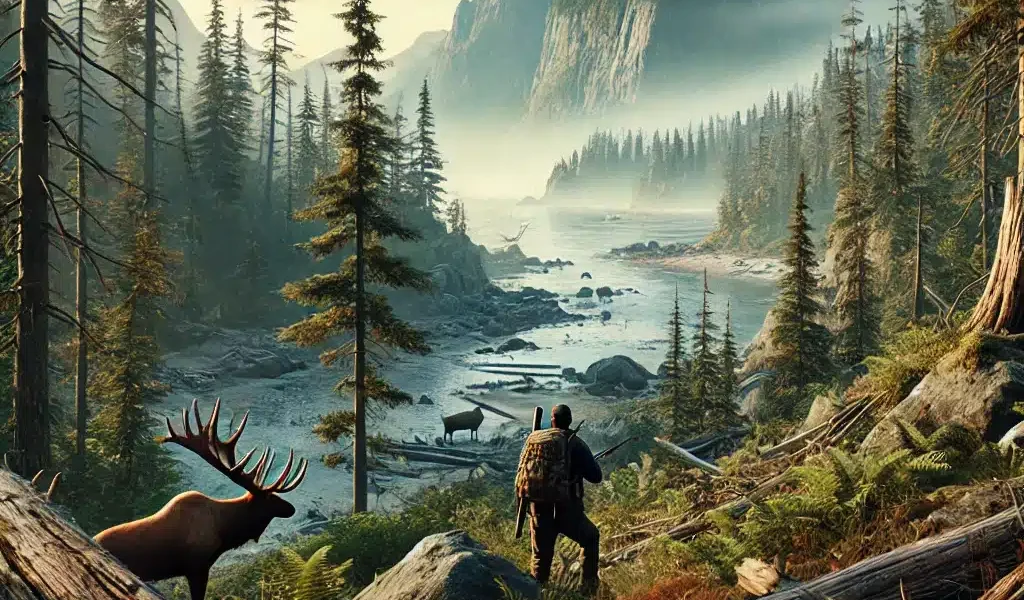
Afognak Island sits just north of Kodiak and offers Alaska’s best elk hunting opportunities. Here’s what makes it special:
Terrain Features
- Dense Sitka spruce forests
- Rolling hills and valleys
- Numerous streams and lakes
- Coastal meadows
- Elevations from sea level to 2,200 feet
Best Units
- Unit 8
- Highest elk population
- More accessible areas
- Better trail systems
- Northern Peninsula
- Less hunting pressure
- Bigger bulls reported
- More challenging access
Access Points
- Afognak Village (southwest)
- Port Lions (south)
- Seal Bay (east)
- Discoverer Bay (north)
Hunting Zones by Skill Level
Beginner-Friendly Areas
- Near Seal Bay
- Better trails
- More gradual terrain
- Closer to emergency services
- Regular elk sightings
Intermediate Zones
- Central forest regions
- A mix of open areas and cover
- Moderate hiking required
- Good glassing opportunities
Expert Territory
- Northern peninsula
- Steeper terrain
- Limited access
- Bigger bulls
- More challenging pack-out
Raspberry Island: The Hidden Gem

Smaller than Afognak but no less promising, Raspberry Island offers:
- Lower hunting pressure
- Smaller areas to learn
- Excellent shore access
- Similar terrain to Afognak
Land Access Considerations
Public Land
- State land (most common)
- Federal wilderness areas
- Native corporation land (requires a separate permit)
Private Land
- Native allotments (need permission)
- Lodge properties
- Guide-leased areas
Pro Tips for Location Selection
Water Sources
- Elk need daily water access
- Look for game trails near streams
- Focus on valley bottoms early season
Food Sources
- Coastal grass meadows
- Berry patches
- Clear cuts with new growth
- South-facing slopes
Bedding Areas
- North-facing slopes
- Thick timber stands
- Protected bowls
- Areas away from typical foot traffic
Travel Routes
- Game trails between feeding and bedding areas
- Saddles between valleys
- Stream crossings
- Beach access points
Weather Considerations by Location
Coastal Areas
- More rain and wind
- Better access
- Easier spotting
- Faster weather changes
Inland Areas
- More protection from elements
- Harder hiking
- Better calling conditions
- More stable weather
Scouting Your Location
Before The Hunt
- Study satellite imagery
- Review topographic maps
- Talk to local guides
- Check weather patterns
During The Hunt
- Glass from high points
- Look for fresh sign
- Track wind patterns
- Note elk movement times
Remember: Success on these islands often comes down to being in the right place and time. The elk are there – you need to be where they want to be when they want to be there.
Essential Gear for Alaska Elk Hunting
Regarding gear, Alaska elk hunting plays by its own rules. The coastal weather and remote locations mean your equipment needs to be bombproof. Let’s break down exactly what you need to keep you safe, comfortable, and successful.
Weather Protection: Your First Line of Defense
Base Layer
- Merino wool or synthetic (no cotton)
- At least 2 sets
- Quick-drying materials
- Thumb holes for wrist coverage
Mid Layer
- Fleece or wool
- Full-zip for venting
- Chest pockets for easy access
- Windproof material preferred
Outer Layer
- Gore-Tex or similar waterproof material
- Reinforced knees and seat
- Quiet material for stalking
- Plenty of pockets
- Hood that turns with your head
Footwear
- Waterproof hunting boots (at least 8″)
- Extra boot laces
- Gaiters (full-length)
- 3-4 pairs of wool socks
- Camp shoes for crossing streams
Weapons and Ammunition
Recommended Rifles
- .300 Win Mag
- .338 Win Mag
- 7mm Rem Mag
- .30-06 Springfield
Ammunition
- 180-220 grain bullets
- At least 40 rounds
- Premium quality (this isn’t the place to save money)
- Practice rounds of the same weight
Optics
- Scope (at least 3-9×40)
- Backup scope rings, mounts
- Binoculars (10×42 recommended)
- Spotting scope (15-45×60)
- Lens cleaning kit
Navigation Tools
Essential Electronics
- GPS unit with extra batteries
- Satellite phone or inReach device
- Backup compass
- Area maps (waterproof)
- Extra batteries for everything
Physical Maps
- Topographic maps
- Unit boundary maps
- Aerial photos
- Waterproof map case
Camping Equipment
Shelter
- 4-season tent (3-person minimum)
- Extra stakes and guy lines
- Ground cloth
- Rain fly
- Tent repair kit
Sleeping System
- 0-degree sleeping bag
- Sleeping pad (insulated)
- Compression sack
- Emergency blanket
Camp Kitchen
- Backpacking stove
- Extra fuel
- Lightweight cookset
- Water filtration system
- Food storage bags
Field Care Equipment
Meat Processing
- Quality hunting knife
- Backup knife
- Sharpening tool
- Game bags (at least 6)
- Paracord (100 feet)
- Latex gloves
- Bone saw
Pack Out Gear
- Frame pack (6000+ cubic inches)
- Cargo straps
- Dry bags
- Compression straps
Safety Gear
Emergency Kit
- First aid kit (comprehensive)
- Fire starting materials
- Emergency shelter
- Signal mirror
- Whistle
- Headlamp with extra batteries
Bear Protection
- Bear spray (2 cans)
- Bear bells
- Hard-sided container for food
- 50′ rope for bear hangs
Pro Tips for Gear
1. Weight Management
- Every ounce counts
- Multi-use items preferred
- Balance weight vs. durability
- Pack weight under 50 pounds before meat
2. Organization
- Color-coded stuff sacks
- Everything waterproofed
- Most-used items accessible
- Critical gear redundancy
3. Maintenance
- Daily gear check
- Evening drying routine
- Battery management
- Weapon cleaning
The Gear Mindset: In Alaska, your gear isn’t just equipment – it’s your survival system. Pack for what could happen, not just what you plan to happen.
Hunting Techniques for Alaska Elk
Let’s explore how to hunt these coastal giants. Alaska elk hunting combines traditional elk hunting skills with unique coastal challenges. The techniques that work in Colorado or Montana need some tweaking here.
Reading the Land
Sign Identification
- Fresh tracks (4-6″ for bulls)
- Droppings (cluster patterns indicate feeding areas)
- Rubs on trees (look for fresh bark removal)
- Wallows near water sources
- Feeding areas in meadows
Coastal Patterns
- Elk often use beaches as travel corridors
- Movement influenced by tide patterns
- Weather pushes elk into timber
- South-facing slopes for morning feeding
- North-facing slopes for bedding
Calling Strategies
Early Season (October)
- Soft cow calls
- Location bugling
- Stick breaking
- Cow/calf conversations
Rut Season (November)
- Aggressive bugling
- Challenge calls
- Cow estrus calls
- Herd bull impersonation
Pro Tip: In the coastal rainforest, sound carries differently. Call softer than you think you need to – elk are often closer than they seem.
Stalking Techniques
The Coastal Approach
- Use wind direction religiously
- Walk on logs when possible
- Step heel-to-toe
- Stop frequently to glass
- Use rain to mask movement
Position Yourself
- Glass from elevated positions
- Set up near natural funnels
- Watch clearings early and late
- Monitor beach access points
- Find natural shooting lanes
Shot Placement and Follow-up
Vital Zones
- Behind shoulder (preferred)
- Quartering away
- Avoid shoulder shots
- Wait for clear vitals
- Consider the angle on slopes
After the Shot
- Wait 30 minutes minimum
- Mark your location precisely
- Blood trail marking system
- Grid search if needed
- Call for help if required
Weather Considerations
Working the Wind
- Morning thermals rise
- Evening thermals drop
- Coastal breezes predictable
- Use ridges to check the wind
- Carry wind checker
Rain Strategy
- Elk move before storms
- Use natural noise cover
- Focus on edges of timber
- Watch meadow margins
- Glass between squalls
Time Management
Daily Schedule
- On position before dawn
- Mid-day scouting
- Evening hunt till dark
- Allow time for pack out
- Plan around tides
Seasonal Timing
- Early season: Pattern-based
- Mid-season: Transitional
- Rut: Calling-focused
- Late season: Food-source focus
Common Mistakes to Avoid
Rushing the Stalk
- Take your time
- Confirm wind
- Plan your route
- Have backup positions
- Consider pack-out route
Poor Shot Decisions
- Know your limits
- Range everything
- Wait for good shots
- Have solid rest
- Consider angles
Inadequate Planning
- Check tide tables
- Know shooting light times
- Have backup plans
- Communicate plans
- Know emergency procedures
Success Tips
Physical Preparation
- Train with pack weight
- Practice shooting positions
- Study elk anatomy
- Learn calling techniques
- Master your gear
Mental Preparation
- Stay positive
- Be patient
- Trust your planning
- Make safe decisions
- Know when to back out
Remember: Alaska elk hunting rewards the patient hunter. It’s not about covering miles – it’s about being in the right place at the right time, ready to make the most of your opportunity.
Field Dressing and Meat Care

In Alaska’s unique environment, what you do after the kill can be just as crucial as what led to it. With warm coastal temperatures and high humidity, proper meat care isn’t just about quality – it’s about saving your harvest.
Immediate Actions After the Kill
- Confirm the animal is down
- Tag your elk immediately
- Take required photos
- Note the exact location (GPS)
- Begin field dressing prep
Field Dressing Steps
Initial Approach
- Check for signs of life
- Position elk downhill if possible
- Clear working area
- Put on field dressing gloves
- Lay out game bags
The Process
- Start with pelvic area
- Work up to sternum
- Careful around stomach/bladder
- Save heart and liver if desired
- Remove windpipe and esophagus
Quartering
- Remove quarters
- Strip backstraps
- Take neck meat
- Save tenderloins
- Remove loose meat
Pro Tip: In Alaska’s environment, speed is your friend. A good rule is to have meat in game bags within 2 hours of the kill.
Meat Care in the Field
Temperature Control
- Get meat off the ground
- Create air circulation
- Use natural shade
- Avoid direct sunlight
- Keep meat dry
Game Bag Management
- Use quality bags (no cheap ones)
- Label each bag
- Keep meat clean
- Allow for airflow
- Don’t overfill
Coastal Considerations
- Watch humidity levels
- Protect from rain
- Use natural cooling
- Consider portable tarps
- Monitor meat temperature
Transportation
Getting Meat Out
- Plan the route before cutting
- Use team if available
- Consider multiple trips
- Mark trail clearly
- Keep load balanced
Pack Out Priorities
- Hindquarters
- Front quarters
- Backstraps
- Neck meat
- Loose meat
Processing Options
Field Processing
- Basic quartering
- Bone-in quarters
- Quick cool method
- Rough cut sections
- Emergency processing
Camp Processing
- More detailed cuts
- Better trimming
- Proper aging
- Quality control
- Better packaging
Professional Processing
- Full service butcher
- Custom cuts
- Vacuum sealing
- Proper aging
- Storage options
Storage and Shipping
Temporary Storage
- Ice chests if available
- Commercial freezers
- Cold storage units
- Processing facilities
- Air-conditioned spaces
Shipping Considerations
- Airline requirements
- Box specifications
- Weight limits
- Dry ice regulations
- Timing issues
Common Mistakes to Avoid
Poor Temp Management
- Leaving meat in sun
- Stacking meat
- Inadequate airflow
- Delayed processing
- Wet game bags
Rushing the Process
- Sloppy cutting
- Missing good meat
- Poor bag preparation
- Inadequate cleaning
- Hasty packing
Inadequate Planning
- No game bags
- Dull knives
- Wrong tools
- Poor pack-out plan
- No backup options
Best Practices for Success
Pre-hunt Preparation
- Sharp knives ready
- Quality game bags
- Processing plan
- Team coordination
- Emergency backup
Field Execution
- Work quickly
- Stay organized
- Keep meat clean
- Monitor temperature
- Document everything
Remember: In Alaska, proper meat care isn’t just about following regulations – it’s about respecting the resource and ensuring quality food for your table.
Safety in the Field
Hunting Alaska elk isn’t just about stalking game – it’s about staying safe in one of the world’s most challenging environments. Let’s break down the essential safety considerations that could save your life.
Bear Safety First
Bear Territory
- Both brown and black bears present
- Increased activity near kills
- Dawn/dusk danger times
- Salmon stream hotspots
- Berry patch encounters
Prevention Strategies
- Hunt in pairs when possible
- Make noise while moving
- Carry bear spray AND backup
- Keep camp clean
- Process kills quickly
If You Encounter a Bear
- Stay calm
- Group together
- Make yourself look large
- Talk firmly
- Back away slowly
Weather Awareness
Reading Weather Signs
- Watch cloud formations
- Monitor wind changes
- Check marine forecasts
- Know local patterns
- Understand micro-climates
Dangerous Conditions
- Sudden fog banks
- Coastal storms
- High winds
- Hypothermia risks
- Lightning exposure
Emergency Response
- Have shelter ready
- Know the closest refuge
- Carry emergency kit
- Understand wind chill
- Monitor team condition
Navigation Safety
Staying Found
- Mark your trail
- Use GPS AND map/compass
- Note landmarks
- Leave detailed plans
- Check in regularly
Getting Lost Protocol
- Stay calm
- Stay put if confused
- Make yourself visible
- Signal for help
- Assess resources
Communication Plans
Primary Methods
- Satellite phone
- inReach device
- Radio if applicable
- Signal mirror
- Whistle signals
Emergency Contacts
- Guide service
- Local authorities
- Air service
- Family contact
- Hunting partners
Medical Preparedness
First Aid Essentials
- Comprehensive kit
- Know how to use it
- Prescription meds
- Emergency training
- Evacuation plan
Common Issues
- Hypothermia
- Twisted ankles
- Cuts/scrapes
- Dehydration
- Physical exhaustion
Hunting Team Safety
Group Guidelines
- Stay within sight/sound
- Regular check-ins
- Meeting points
- Emergency signals
- Buddy system
Equipment Checks
- Daily gear inspection
- Weapon condition
- Safety equipment
- Navigation tools
- Communication devices
Field Safety Checklist
Morning Check
- Weather forecast
- Equipment status
- Team condition
- Route plan
- Emergency gear
Evening Check
- Location confirmation
- Team accountability
- Equipment status
- Weather update
- Next day planning
Emergency Procedures
If Someone’s Injured
- Assess situation
- Stabilize victim
- Call for help
- Mark location
- Prepare for evacuation
If Lost
- Stop movement
- Check resources
- Signal position
- Create shelter
- Wait for help
Pro Safety Tips
Prevention
- Stay physically fit
- Know your limits
- Check equipment
- Study area
- Have backup plans
Preparation
- Practice emergency scenarios
- Know your gear
- Update first aid skills
- Maintain communication
- Keep emergency numbers
Remember: In Alaska’s backcountry, your safety plan isn’t just a good idea – it’s your lifeline. The best hunters are the ones who come home to tell their stories.
Common Mistakes to Avoid
Gear Failures
- Cheap rain gear
- Inadequate boots
- Wrong ammunition
- Poor optics
- Light sleeping bags
Mental Errors
- Rushing shots
- Ignoring weather
- Poor preparation
- Giving up too soon
- Taking risky shots
Physical Mistakes
- Lack of conditioning
- Wrong food choices
- Dehydration
- Over-exertion
- Poor rest management
Expert Tips for Success

Pre-Hunt Preparation
1. Physical Training
- Uphill hiking with a pack
- Core strength exercises
- Shooting practice
- Cardio endurance
- Recovery techniques
2. Mental Preparation
- Study area maps
- Learn elk behaviors
- Practice calling
- Plan contingencies
- Set realistic expectations
3. Equipment Testing
- Test all gear
- Break in boots
- Verify zero
- Weather-proof equipment
- Pack and repack
Field Strategies
1. Hunt Smart
- Glass more, walk less
- Use terrain features
- Work with weather
- Follow game trails
- Trust your gut
2. Stay Efficient
- Conserve energy
- Maintain equipment
- Eat and drink regularly
- Rest when needed
- Pace yourself
3. Be Adaptable
- Change tactics as needed
- Listen to locals
- Learn from mistakes
- Stay flexible
- Keep positive
Lessons from Successful Hunters
What Worked
- Quality gear investment
- Physical preparation
- Local knowledge
- Patience
- Team approachv
What Didn’t
- Rushing into areas
- Ignoring weather signs
- Poor meat care
- Solo pack-outs
- Inadequate planning
Final Words of Wisdom
From Pete (30-Year Alaska Guide): “Success on an Alaska elk hunt isn’t just about the kill. It’s about the experience, the preparation, and most importantly, doing it safely. Every successful hunter I’ve guided had three things in common: they were prepared, patient, and positive.”
Remember: “Alaska elk hunting will test you in ways other hunts won’t. But that’s exactly what makes it special. Come prepared, stay humble, and enjoy one of hunting’s greatest adventures.”

